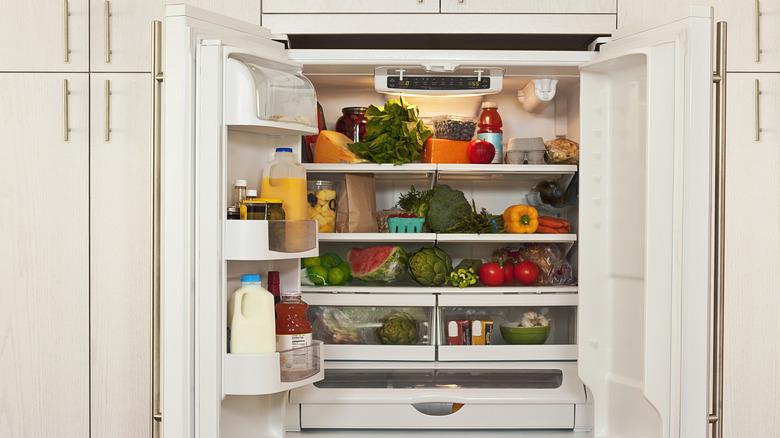The Importance Of Airflow In Keeping Refrigerated Produce Fresh
There is way more to refrigerators than meets the eye. While you would be forgiven for thinking they're just big cold storage boxes, they're actually fully constructed environments where, in addition to temperature, airflow plays a crucial role. When air becomes stagnant, moisture accumulates, and when moisture accumulates, temperature becomes inconsistent. And if the temperature is inconsistent, your fridge isn't doing its job properly which leads to food spoiling quicker. It's very possible that the slime that sometimes appears under your head of lettuce is simply the result of poor air circulation!
Proper airflow in the fridge helps keep the right conditions by evenly distributing cold air and preventing the formation of warm pockets — which are definitely no-no as warmth is a surefire way to create bacterial growth and mold. But it isn't just your food spoiling to be mindful of. Bad airflow can also impact the flavor and texture of your produce. For example, the best way to store apples is to keep them in the crisper drawer to maintain the correct temperature for a crisp texture.
Cold air sinks, so without proper circulation, temperature layers can form in your fridge. And if that happens, one shelf may remain cool while another becomes warmer and if you're keeping something sensitive on it, like blueberries, they'll spoil fast. These are the kinds of storage mistakes that are ruining your food.
How fridge layout and packaging influence airflow
To fight these issues, avoid overloading the refrigerator and make sure that the air vents are not blocked to allow the air to flow freely around your fridge. Even the most fancy and up-to-spec refrigerator will struggle with good airflow if it's all packed wrong. Filling the shelves up too much or blocking the air vents is an easy way to make sure your expensive fridge isn't doing its job.
How you store your food inside the fridge is also something you should consider. Fully sealed plastic bags aren't able to get any airflow, so keeping things inside them can cause moisture to get trapped inside. For produce with a high water content, the best storage depends on the item: Mushrooms do well in paper bags in the vegetable crisper, whereas cucumbers and bell peppers do better in the vegetable crisper in perforated plastic bags.
And since airflow in the fridge is uneven, this placement does matter. More delicate fruits like berries should be kept on middle or top shelves, where temperatures are more stable, and produce that's more durable can have more of a free roam (but keep ethylene-sensitive items like leafy greens away from gas-producing fruits like apples or bananas). And many foodstuffs, like tomatoes, do better out of the fridge altogether — so avoid storing these 12 foods in the fridge to keep them fresher for longer.

